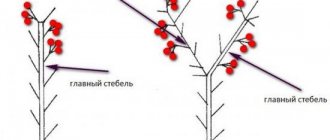The Pink Elephant variety is very responsive to care. Experienced gardeners who know how to properly water and feed tomatoes can annually receive good harvests of large and tasty fruits when planting this cultivar.
| Height | Landing location | Ripening time | Fruit color | Fruit size | Origin | Fruit shape |
| Medium height | Greenhouse, Open ground | Mid-season | Pink | Large | Variety | Flat-round |
Description of fruits and characteristics of the variety
The pink elephant was created in the State Register since 1998. It is recommended to be planted by amateur gardeners and small farmers.
Have you already grown Pink Elephant tomato?
Yes
50%
No
50%
Description of the bush
The tomato is semi-determinate and should grow up to 150-170 cm. But, according to reviews, this is true only under film covers. In vegetable gardens it is lower. In permanent greenhouses, those who planted them often complain that the bush reaches 2 m and can stretch further; in general, it behaves like an indeterminate plant, but the first cluster is planted above the 7th leaf. Subsequent ones are formed through 2-3 plates.
The Pink Elephant tomato variety has potato-type plates. The leaf segments are not dissected, but solid, heart-shaped. On the one hand, the area of nutrition and photosynthesis increases. But on the other hand, more moisture evaporates, the bush needs to be watered more often, and in regions with problematic climates, tomatoes receive less light in cool summers. True, in the southern regions this turns into an advantage - a medium-ripening variety, the leaves protect the tomatoes from the scorching sun and heat.
Fruit characteristics
Pink elephant tomatoes are multi-chambered, flat-round, the size is very different on the lower and upper clusters. The largest ones ripen closer to the ground, at the base of the shoots, without rationing they reach a maximum weight of 400 g. Tomatoes weighing 150 g or less are located at the top.
They are ribbed in the tail area, and the larger the fruit, the more pronounced the folds. The smallest ones, located on the upper hands, have a usually smooth surface.
The skin is green at technical ripeness, and after ripening it is raspberry-pink (see photo). The flesh, like all beefs, is fleshy, tender, with a small amount of seeds. The taste is excellent, sweet.
Fruiting and productivity
Pink elephant is a mid-season tomato. In total, during the growing season, 8-12 clusters with 4-8 flowers can form, but not all of them will ripen. It is recommended to leave no more than 5, and pinch the ends of the bunches.
Pollination in open ground occurs well. In order to get a harvest, you need to attract bees to greenhouses, and shake the bushes during flowering.
According to the State Register, from the 1st quarter. m, they harvest from 6.2 to 8.2 kg of tomatoes, but they provide somewhat underestimated data, and only for marketable yield. In large-fruited varieties it is usually significantly lower than the total. The manufacturer claims that with good care, depending on the planting density, such an area in a good year yields 9-12 kg.
Reviews
Summer residents leave rather conflicting reviews about this variety. Some people like the yield, disease resistance, large fruits and taste. But for others, the taste, on the contrary, seems bland. Some also note the importance of timely staking and regular pruning in the greenhouse - otherwise the bushes shade other crops, reducing their yield.
But in general, most summer residents are satisfied. Even if they do not abandon other varieties in favor of the “pink elephant,” they still agree to allocate several beds for it in order to obtain large, tasty, fleshy fruits in the fall.
Planting dates and care
From the moment the seeds peck to the first colored fruits, the Pink Elephant will take approximately 112 days. Moving to a permanent place is carried out at 45-55 days of age. By this time, the soil outside should warm up:
- for greenhouses – up to 10° C;
- when grown in the garden - up to 15° C.
You can calculate the exact timing yourself. It is recommended to focus on the long-term weather forecast and climate of the region.
Growing seedlings
The manufacturer advises soaking the seeds in a stimulant before sowing. In addition, they need:
- warm up;
- disinfect;
- soak until it swells.
Sowing is done to a depth of about 1-1.5 cm. The grains are laid out every 1-2 cm in lines, with 4 cm left between them to allow loosening of row spacing.
Seeds are germinated at high temperature (23-25° C) and humidity. After pipping, they are transferred to a cool room with round-the-clock lighting for a week to prevent stretching.
Then the temperature is raised to 20°. Additional lighting is reduced to 12-14 hours. They dive in the phase of 2 true leaves. After growth resumes, feed with a mineral complex with a high nitrogen content. Harden 2 weeks before moving to a permanent place.
Care after transplant
For 1 sq. meter, place 3 bushes if you are going to grow a Pink Elephant into 2 trunks, and 4 when forming one shoot. Tomato:
- water regularly but moderately;
- after extending the second brush, reduce the amount of nitrogen in fertilizers to a minimum, increase the doses of potassium, calcium, phosphorus;
- the soil is mulched.
Formation and rationing
This is an important element of care that makes sense to dwell on separately. The growth of the Pink Elephant bush is usually self-limited after the extension of 8-12 brushes. If this does not happen, the top continues to grow, flowers and ovaries form, which prevents the lower fruits from gaining mass and ripening.
To get large, sweet tomatoes, topping should be done after 4-5 grapes or 45 days before the expected end of the season.
At the tips of the bunches, tomatoes do not always set or grow small, and only draw back nutrients. It is recommended to pinch them, leaving 3-4 apples at the base of the bunch.
The larger the tomatoes you want to get, the fewer ovaries there should be on the bush.
The plant will have to be tied and shaped. They lead into 1-2 trunks, the remaining stepsons are regularly removed - the growth power of the Pink Elephant is great, if you miss the moment, it will not only produce long side shoots, but will also have time to put out flower clusters.
That is why the variety is not recommended to be grown in dachas visited on weekends. In a week it will acquire stepsons, which take a lot of strength and nutrients. The leaves require more moisture and actively evaporate it; with irregular watering, the plates curl and can dry out in a hot year. What’s even worse is that the fruits crack, fungal spores get into the wounds, and gardeners remain dissatisfied with their quality, as they complain about in the video: The leaves under the clusters that have begun to swell are removed. It is also recommended to tie the brushes to a vertical support - they are heavy and creases are possible on the stems.
About growing tomatoes
Tomatoes of this variety are included in the State Register and are included in the top twenty best tomatoes in the country every year. To achieve good results, it is necessary to comply with certain requirements, starting from the very first stage.
Features of planting seedlings
Seeds are sown 2 months before placement in the ground. Gardeners usually plan the second half of March for sowing. Before this, prepare special containers:
- containers with lids;
- deep containers with a tray, the ability to make drainage holes.
Seeds are usually specially treated before sowing. They are soaked for 10 hours.
Information! For soaking, use a saline solution or a growth stimulator.
For sowing, take a mixture of garden soil and humus; it is recommended to add river sand or wood ash.
- The soil is placed in containers.
- Seeds are planted 2 centimeters deep.
- Plantings are sprayed with water.
- Cover with film to create a greenhouse effect.
- The film is removed after germination.
- For good growth and development of seedlings, provide access to light and regular watering with warm water.
See also
Description of the King Kong tomato and recommendations for growing the plant
Read
Lighting for seedlings
If there is a lack of light, tomatoes should be provided with additional sources. Daylight lamps are suitable for this; the method requires maintaining a balance between light and watering.
Picking
Seedlings of the variety need to be pinched after the first leaves appear. They are removed, and the sprouts are planted in separate containers.
Hardening of seedlings
This technique is used to grow seedlings that are strong and resistant to temperature changes. The seedlings are under the film for the first 5 days. After this, the film is removed, the temperature above the soil drops to +15-16 degrees. Then it gradually levels out with room temperature.
Landing in the ground
Planting on open areas of land is carried out only when the soil is sufficiently warmed up. To facilitate this process, a week before the intended procedure, the ground is dug up and then covered with film material. Greenhouse conditions require simple digging of the soil.
A layer of ash is placed in the hole, then the sprout is dug in, compacted, and spilled with water. To ensure conditions around the planted plant, a trench is dug. This allows the soil to retain moisture and makes further watering easier.
A certain landing pattern has been adopted for the Pink Elephant:
- open ground - early June;
- greenhouse conditions – second half of May.
Similar varieties
According to the characteristics and description of the Pink Elephant variety, it is similar to tomatoes:
- Bugai pink of agro selection - lettuce, determinate, in the State Register since 2014. Bush 1.5-1.8 m high. Tomatoes ripen 118 days after germination, multi-chambered, pink, often with a spot at the stalk, slightly ribbed, flattened in shape. The taste is sweet, rated 4.9 out of 5, average weight - 310 g. Productivity - about 6 kg per plant.
- Your Nobility - a variety from Siberian Garden for open or protected ground. Mid-season, determinate, 1.2-1.4 m high. Fruits weighing 350-450 g, pink, with sugary fleshy pulp. Yields 6 kg per bush. In the garden you can only plant up to the first cluster, but it definitely requires a garter.
- Pink brandy – salad, ripens in the middle period, part of the “Vkusnoteka” series. In the State Register since 2015, agro selection. The plant is indeterminate, reaches a height of 150-160 cm, leaves are potato-type. Multi-chambered tomatoes are pink, ribbed, flat-round in shape, very tasty, sweet, the lower ones weigh 250-450 g, they become smaller up to 150 g on the upper clusters. From 1 sq. m are collected from 6.6 kg.
Pink elephant is an excellent beef tomato. The fruits are tasty, with tender fleshy pulp. Care is simple, but the formation and tying of the bush cannot be neglected or carried out occasionally.
The benefits of the Pink Elephant tomato
Tomato is a favorite vegetable crop, which during the season, in fresh form, practically never leaves people’s dinner tables. In addition to its taste and breathtaking aroma, the variety is distinguished by a good range of useful elements that are included in its composition:
- vitamins (A, E, B, C, PP, K);
- antioxidants;
- cellulose;
- beta-carotene;
- microelements.
In addition to useful elements, tomato is a low-calorie vegetable; it is recommended to be consumed in the daily diet by people with problems of excess weight, metabolism in the body, and liver problems.











